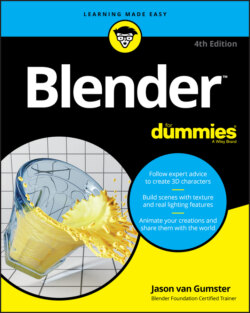Читать книгу Blender For Dummies - Jason van Gumster - Страница 13
Discovering Blender’s origins and the strength of the Blender community
ОглавлениеThe Blender you know and love today wasn’t always free and open source. Blender is actually quite unique in that it’s one of the few (and first!) software applications that was “liberated” from proprietary control with the help of its user community.
Originally, Blender was written as an internal production tool for an award-winning Dutch animation company called NeoGeo, founded by Blender’s original (and still lead) developer, Ton Roosendaal. In the late 1990s, NeoGeo started making copies of Blender available for download from its website. Slowly but surely, interest grew in this less-than-2MB program. In 1998, Ton spun off a new company, Not a Number (NaN), to market and sell Blender as a software product. NaN still distributed a free version of Blender, but also offered an advanced version with more features for a small fee. There was strength in this strategy and by the end of 2000, Blender users numbered well over 250,000 worldwide.
Unfortunately, even though Blender was gaining in popularity, NaN was not making enough money to satisfy its investors, especially in the so-called “dot bomb” era that happened around that time. In 2002, NaN shut its doors and stopped working on Blender. Ironically, this point is where the story starts to get exciting.
Even though NaN went under, Blender had developed quite a strong community by this time, and this community was eager to find a way to keep their beloved little program from becoming lost and abandoned. In July of 2002, Ton provided a way. Having established a non-profit organization called the Blender Foundation, he arranged a deal with the original NaN investors to run the “Free Blender” campaign. The terms of the deal were that, for a price of €100,000 (at the time, about $100,000), the investors would agree to release Blender’s source code to the Blender Foundation for the purpose of making Blender open source. Initial estimations were that it would take as long as six months to one year to raise the necessary funds. Amazingly, the community was able to raise that money in a mere seven weeks.
Because of the Blender community’s passion and willingness to put its money where its metaphorical mouth was, Blender was released under the GNU General Public License on October 13, 2002. With the source in the community’s hands, Blender had an avalanche of development and new features added to it in a very short time, including somewhat common features like Undo (a functionality that was conspicuously missing and highly desired since the initial releases of Blender by NeoGeo).
Nearly two decades later, the Blender community is larger and stronger than ever. Blender itself is a powerful modern piece of software, competitive in terms of quality with similar software costing thousands of dollars. Not too shabby. Figure 1-1 shows screenshots of Blender from its early days to the Blender of today.
FIGURE 1-1: Blender through the years: Blender 1.8 (top left), Blender 2.46 (top middle), Blender 2.72 (top right), and the major changes apparent in the Blender of today (bottom).
